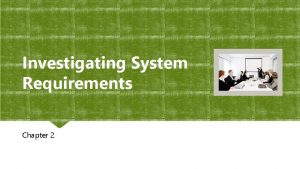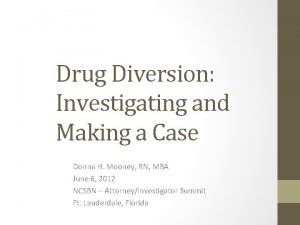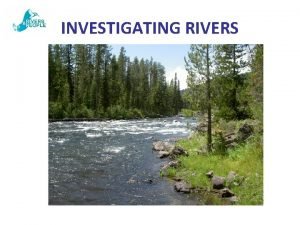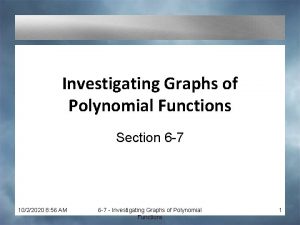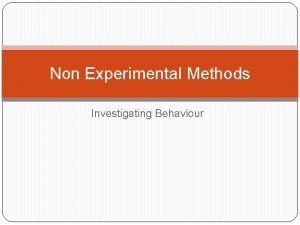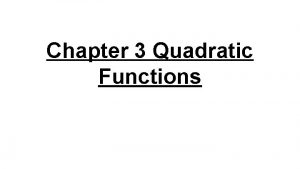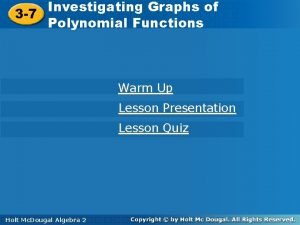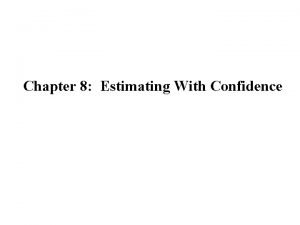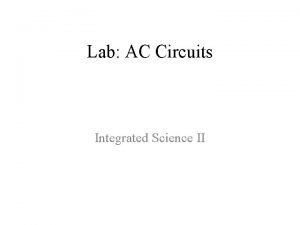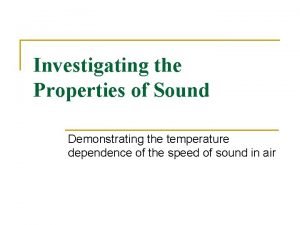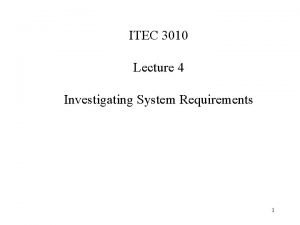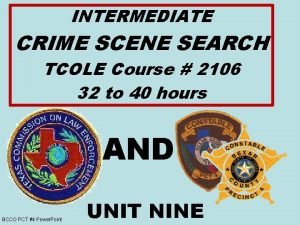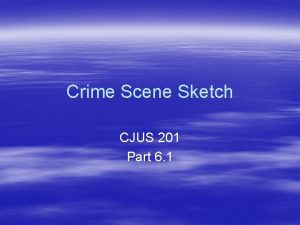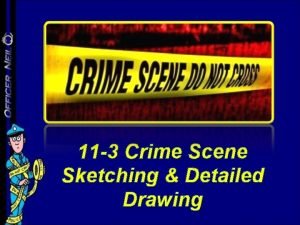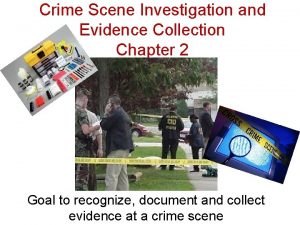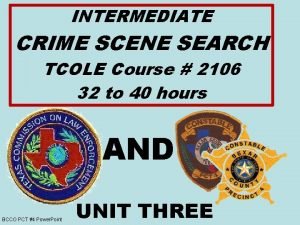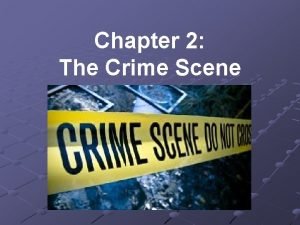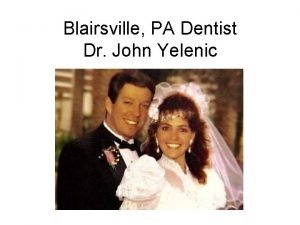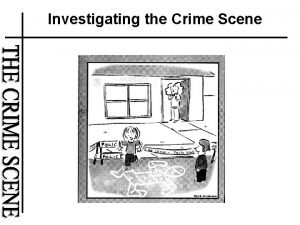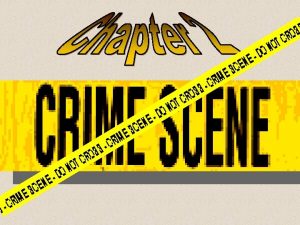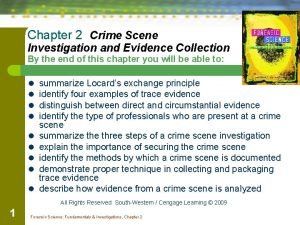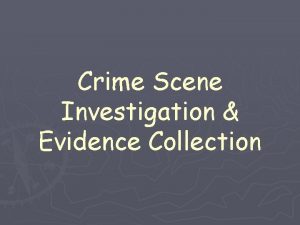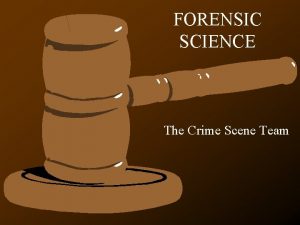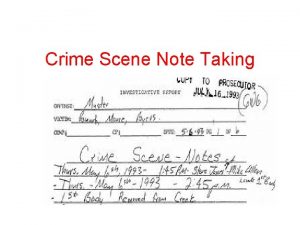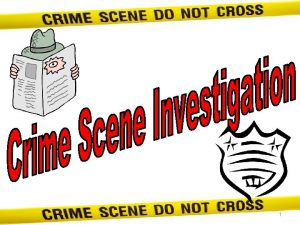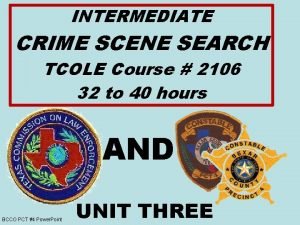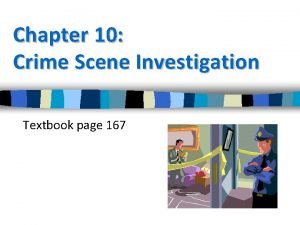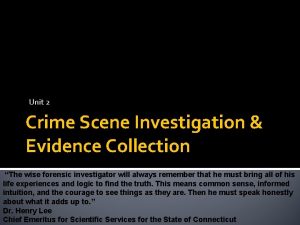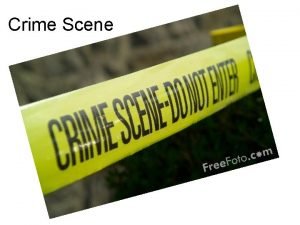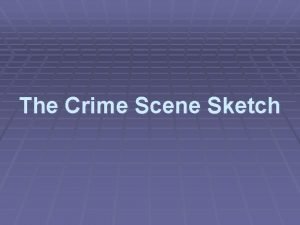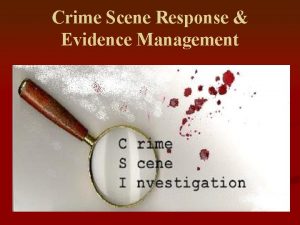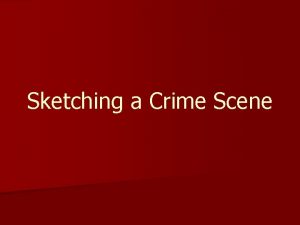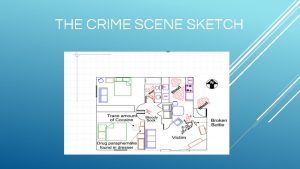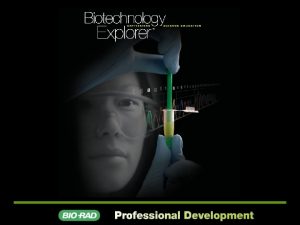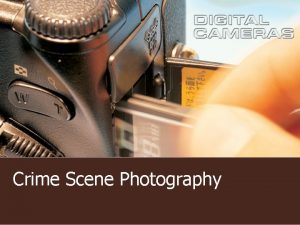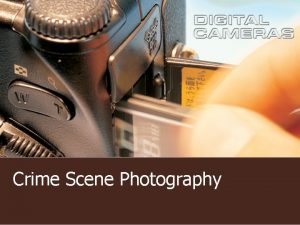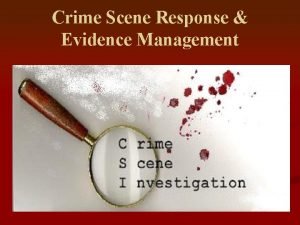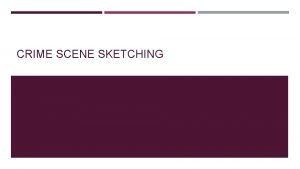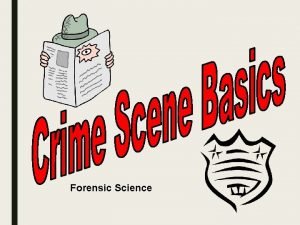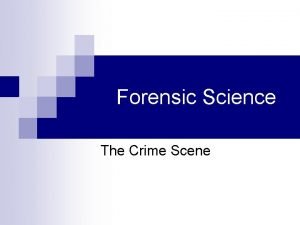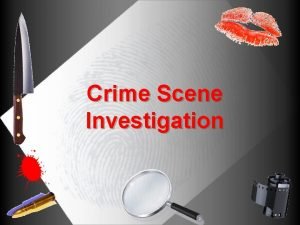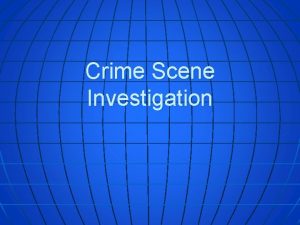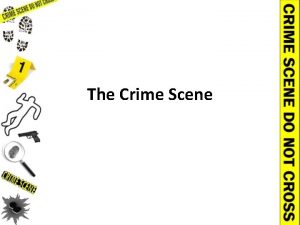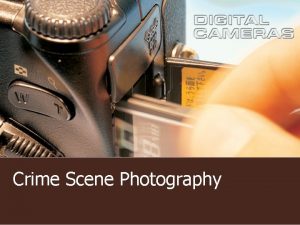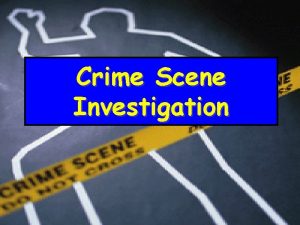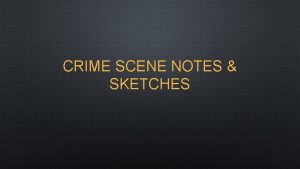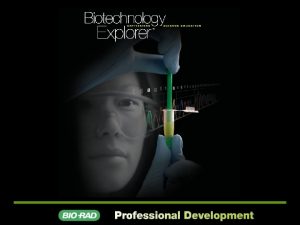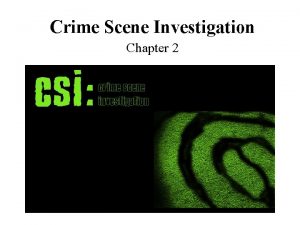Investigating the Crime Scene Responding to a Crime


















































- Slides: 50

Investigating the Crime Scene

Responding to a Crime Scene • First responder (usually a police officer) – Offers assistance to injured persons – Identifies witnesses and suspects – Identifies the scope of the scene and secure it – Documents the conditions of the scene – Protects the evidence • Later responders (detectives and/or CSI’s) – Contacts first responder for overview of scene – Directs the investigation – Collects evidence and/or statements

Securing the Crime Scene

Securing the Crime Scene • • • Set initial boundary larger than the scene Create a staging or work area outside the scene Locate physical evidence for collection Create single path in and out of scene Document all actions taken by responders: – Personal information – Actions and statements of persons entering and exiting the scene – Items moved or removed and who moved them

Crime Scene Investigation Team What do you think is each person’s role in investigating the crime scene below?

Crime Scene Investigation Team • Police officers- Typically the 1 st to arrive at a scene. Secures the scene and initially interviews witnesses. • Detectives- interviews the first responder, interviews witnesses and examines the overall scene, coordinates work of crime scene investigators about the evidence and ME/Coroner about the victim. • Crime Scene Investigators- document scene in detail, collect and record evidence. • Medical Examiners/Coroners- determine cause of death if homicide has occurred, transport the body to the morgue.

CSI Processing of a Crime Scene 1. The lead CSI investigator will get a report from the first responder or detective then evaluate the area. 2. The lead CSI then proceeds with an initial walkthrough to gain an overview and develop a strategy for a systematic search and documentation of the entire crime scene. 3. CSI’s search and document the scene with photography and sketches while identifying and documenting all evidence. 4. CSI’s Package movable evidence and process for latent prints, impressions, blood stains etc that cannot be moved.

The Search • The search for physical evidence at a crime scene must be thorough and systematic. • The search pattern selected will normally depend on the size and locale of the scene and the number of evidence collectors. • Investigators wear gloves and shoe protectors to prevent contamination of the scene. • Begin searches outside or at the point of entry or exit and move inward.

The Search • Level I Search- Survey of the crime scene. Nothing is touched, the eyes are the only tools utilized. • Level II Search- moving items that cause minimal intrusion to the scene. Examples are opening closet doors, cabinets, moving heavy furniture. • Level III Search- most intrusive which includes emptying every draw at a crime scene or overturning mattress. Also consist of searching each pocket the victims cloths or cloths in a closet. Carpet or wall or can be taken out. (Latent prints and luminal is utilized at this stage)

Systematic Search for Evidence

Documenting the Scene • Documenting is the most important and timeconsuming activity at a crime scene because: – It shows the evidence in the context of the crime scene. – It allows detectives and crime scene analysts to do a reconstruction of the corpus delecti. – Helps create and maintain the chain of custody. – It may become evidence in court. • Notes, photographs and diagrams are all used to document the crime scene and the location of physical evidence.

Taking Notes • Describe everything; the location, weather, type of crime, all physical evidence, etc. • Make notes in ink, in a bound notebook, with pages numbered sequentially. • Do not erase errors; cross them out with pen. • Make notations in chronological order. • Evidence is documented by describing: • Type and condition of evidence • Time of discovery • Name of discoverer • Placement, collection, packaging, labeling

Photography

Photography • You can never take too many photos of a crime scene. At a death scene there may be 200 -500 shots taken from every possible angle of view. • Victims and evidence must not be moved until they have been photographed from all necessary angles. • Physical evidence is photographed with a scale to show it’s size and also it’s location relative to the entire scene.

Photography • Use a 35 -mm single-lens reflex camera and learn how to manipulate ALL its settings. • Archive the original digital images and work with copies. • A photo log must also be created. – Date and time – Camera settings – Film roll number and exposure number or file name and exposure number – Type of shot – Distance to the subject – Brief description

Photography

Outdoor Photography

Outdoor Photography

Indoor Photography Living Room What other photos should be taken in these rooms? Bedroom

Indoor Photography

Learning Check Mark on the sketch or describe the positions where photographs of the crime scene and the evidence should be taken.

Sketches • Rough Sketch—A representation of all essential information, evidence and measurements at a crime scene drawn at the crime scene.

Other Ways to Document the Scene & Evidence • Videography – May be used to complement still photography – Is the best way to document the overall view of the scene – You must still record the locations of evidence in still photos. • Record a running audio narrative; but this must be transcribed into a report. • Leica Geosystems Scan. Station can be used to create a digital image of the entire crime scene.

Investigating the Crime Scene

Sketches • Rough Sketches – use an overhead view – not drawn to scale, but with accurate distances – establish two fixed reference points • Other items included in a sketch: – Case identifier, sketch artist – Date, time, location, weather, lighting – Identity and assignments of personnel present – Key or legend – Compass direction or geographic orientation

Sketches Finished Sketch—A precise rendering of the crime scene, usually drawn to scale. This type is not normally completed at the crime scene.

Learning Check What important elements are missing from the crime sketch below?

Collection of Evidence This is a photo of a burglary crime scene. Which items should be collected and why?

Collection of Evidence • Flashlights or ALS (alternate light sources) are used to help identify evidence for collection. • Once identified and documented, the evidence must be collected, preserved, packaged and inventoried in preparation for submission to the crime lab. • Reference samples should be collected from relevant persons or from the scene and are used for comparison. • Disposable gloves are always worn, and often changed, to protect evidence from contamination.

Collection of Evidence • Impression evidence (fingerprint, shoe print, etc. ) – Identified by sight, ALS or chemical reagent – Enhanced by use of special photographic techniques or by chemical developers – Collected by lifting tape or molding materials • Biological evidence (blood, semen, etc. ) – Identified by sight, ALS or chemical reagent – Collected with sterile swabs • Firearms and ammunition (gun, bullet, shell, etc. ) – Must be rendered safe for transport – Stored in paper envelopes, bags, or boxes

Collection of Evidence • Arson evidence (flammables, ignition source, etc. ) – Locate by sight and smell – Place carpet, wood, and absorbent materials in clean paint cans and seal lid – Place flammable liquids in glass bottle with tight -fitting lid • Chemicals and controlled substances (drugs) – Locate by visual observation – Chemical field tests are used to classify or identify them at the scene – Place liquids or solids in a screw cap jar or vial

Collection of Evidence • Trace evidence (hair, fibers, soil, etc. ) – May be extremely small or microscopic – Collect by forceps, tweezers, scraping, taping, or vacuuming – Document and collect questioned and known samples – Work in conjunction with medical examiner for homicide evidence collection

What Evidence Would You Collect and How Would You Collect It?

Packaging Evidence • Each item must be placed in a separate container to prevent cross-contamination. • The package should be clearly labeled and sealed with evidence tape. • Take entire piece of evidence as it is found at the scene, if possible. • Wet blood should either dry first and then be scraped or can be collected on a swab.

Is this evidence properly packaged? Why or why not?

Packaging Evidence • Unbreakable plastic pill bottles with pressure lids are excellent containers for hairs, glass, fibers, and other kinds of trace evidence. • Manila envelopes, screw-cap glass vials, or cardboard pillboxes are also good containers. • Paper bags and boxes can be used for larger and/or heavier pieces of evidence. • Ordinary mailing envelopes should not be used because powders will leak out of their corners. • Arson evidence is placed in clean paint cans.

Learning Check What type of evidence should go in each type of container below? 1. Bloody clothes 2. White powder 3. Glass fragments 4. Burned wood

Beyond The Crime Scene The medical examiner or coroner will examine the victim to establish a cause and manner of death and preserve tissues and organs for analysis. They may also collect some or all of the following: 1. Victim’s clothing 2. Fingernail scrapings 3. Body hairs 4. Blood 5. Vaginal, and oral swabs 6. Bullets or other objects inside the body 7. GSR swabs from shooting victims

Submitting Evidence to The Lab • Evidence should be sent directly to the lab to preserve the chain of custody. • It may be submitted to the lab in person or via mail or commercial package delivery. • Chemicals, radiological agents, and explosives may be transported via UPS or Fed. Ex. • Once at the lab, the evidence is placed in secured storage areas and logged as to location.

Chain of Custody

Chain of Custody • In court, all evidence will be subject to questions about chain of custody. • The chain starts with the evidence’s original discoverer. • The chain is broken if movements are not documented; that may result in evidence being excluded in court. • Preserve the chain of custody by making sure that investigator documents everything that happens to each piece of evidence at the scene and once it is in the lab.

Investigating the Crime Scene

Evidence and the Fourth Amendment US Constitution, Fourth Amendment The right of the people to be secure in their persons, houses, papers, and effects, against unreasonable searches and seizures, shall not be violated, and no Warrants shall issue, but upon probable cause, supported by Oath or affirmation, and particularly describing the place to be searched, and the persons or things to be seized.

Evidence and the Fourth Amendment • Evidence is most often excluded due to Fourth Amendment violations. • Officers must present an affidavit of probable cause that criminal activity is taking place at a particular location to receive a search warrant. • Contraband, “fruits and instrumentalities of the crime, ” evidentiary items, voice and handwriting can all be obtained via warrants. • Only the areas or items explicitly described in the warrant can be searched and taken.

Exceptions to the Fourth Amendment • Border searches: customs searches at the border do not require a warrant. • Consent searches: persons can voluntarily submit to a search but can rescind it at any time. • Search incident to arrest: persons and the area under their immediate control can be searched during a lawful arrest. • Plain view doctrine: officers can seize contraband evidence that they can see from a legal vantage point.

Exceptions to the Fourth Amendment • Emergency exceptions: officers can enter premises without a warrant if they have reasonable suspicion that an injured person is inside. • Open fields: no expectation of privacy. • Stop and frisk: officer may pat down a suspicious person who may be armed and dangerous. • Vehicle inventories: the search of a vehicle can be done if the driver or occupant is arrested. • There is NO murder scene exception.

Evidence and the Fourth Amendment • Mincey v. Arizona (1978) – Police conducted an undercover raid of a suspected drug house. – An officer and three suspects were shot. – The premises were searched extensively over 4 days without a warrant. – The court overturned the conviction: The offense did not merit a warrantless search because the evidence would be not lost while a warrant was obtained.

Evidence and the Fourth Amendment • Michigan v. Tyler (1978) – It involved a fire at a furniture store. – Investigators conducted several searches during the day including some well after the fire was out. – The convictions were overturned: The later warrantless entries were not part of the initial emergency circumstances. • Bottom Line: Officers must obtain a search warrant before they conduct any careful, detailed examination of a crime scene.

Learning Check In a neighborhood well known for producing methamphetamines, the police have a warrant to search the basement of a home to find a production lab. Finding nothing in the basement, they perform a search on the rest of the house. In an upstairs bedroom find a kilo of marijuana, which they seize and then arrest the occupant. Is this search legal or illegal? Why or why not?

Investigating the Crime Scene
 Unit 14 investigating customer service
Unit 14 investigating customer service Investigating system requirements
Investigating system requirements Investigating rivers
Investigating rivers Investigating the graph of an inequality
Investigating the graph of an inequality What is this shape
What is this shape Investigating science hsc
Investigating science hsc Module 1 review questions
Module 1 review questions Investigating the world of work. lesson 1
Investigating the world of work. lesson 1 Investigating specific heat capacity
Investigating specific heat capacity Investigating skills. thomas edison
Investigating skills. thomas edison Digital graphics to entertain
Digital graphics to entertain Investigating and making a case for drug diversion
Investigating and making a case for drug diversion Investigating graphs of functions for their properties
Investigating graphs of functions for their properties Investigating rivers
Investigating rivers Cpalms investigating plant and animal cells
Cpalms investigating plant and animal cells Investigating graphs of polynomial functions
Investigating graphs of polynomial functions Methods of investigating behaviour
Methods of investigating behaviour Investigating polynomials
Investigating polynomials Language meaning
Language meaning Investigating graphs of functions for their properties
Investigating graphs of functions for their properties Investigating quadratics
Investigating quadratics Investigating graphs of polynomial functions
Investigating graphs of polynomial functions Suppose your class is investigating the weights of snickers
Suppose your class is investigating the weights of snickers Unit 14 investigating customer service assignment 1
Unit 14 investigating customer service assignment 1 Integrated science lab experiments
Integrated science lab experiments Investigating the properties of sound
Investigating the properties of sound Investigating system requirements
Investigating system requirements Linear search pattern crime scene
Linear search pattern crime scene 2106 crime scene investigation
2106 crime scene investigation Cross projection sketch crime scene
Cross projection sketch crime scene Drawing of crime
Drawing of crime While the csi team is searching the crime scene, _____.
While the csi team is searching the crime scene, _____. Intermediate crime scene search #2106
Intermediate crime scene search #2106 Youtube.com
Youtube.com West memphis 3 victims autopsy
West memphis 3 victims autopsy Margaret schlosser baby
Margaret schlosser baby James russell odom
James russell odom Murder of john yelenic
Murder of john yelenic Crime scene investigation background
Crime scene investigation background Crime scene
Crime scene Crime scene storyboard
Crime scene storyboard Where does forensic science begin
Where does forensic science begin Crime scene factoring and quadratic functions answer key
Crime scene factoring and quadratic functions answer key Locard exchange principle
Locard exchange principle Crime scene reconstruction involves forming a hypothesis
Crime scene reconstruction involves forming a hypothesis Deductive reasoning crime scene investigation
Deductive reasoning crime scene investigation Note taking crime scene investigation
Note taking crime scene investigation The term encompasses all objects that can establish
The term encompasses all objects that can establish Crime scene investigation 2106
Crime scene investigation 2106 Csi search patterns
Csi search patterns Seven s's of crime scene investigation description
Seven s's of crime scene investigation description

